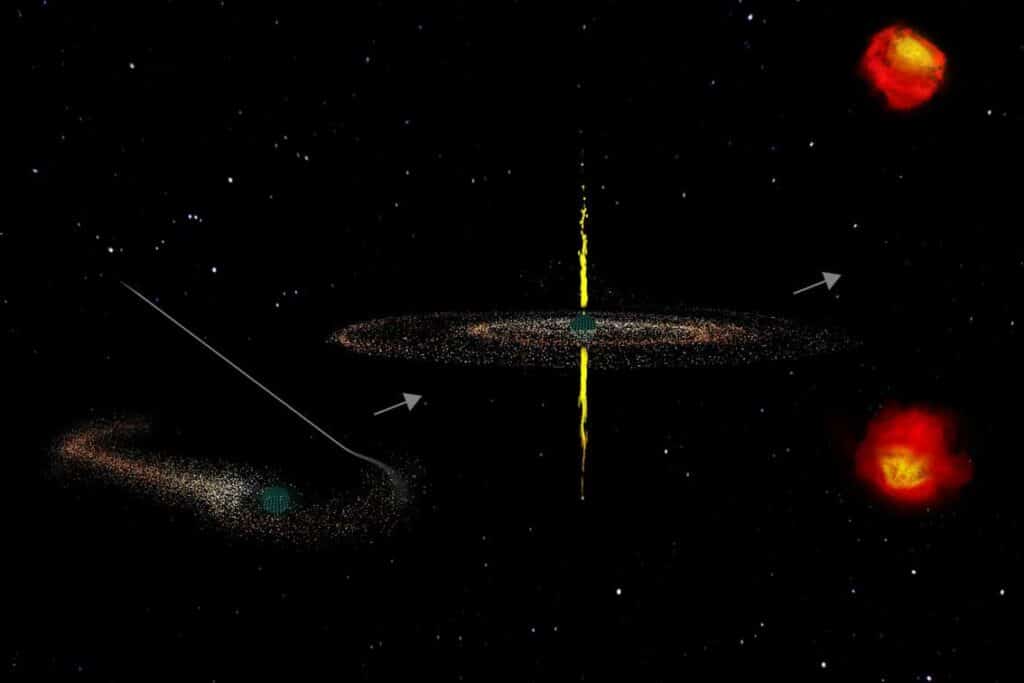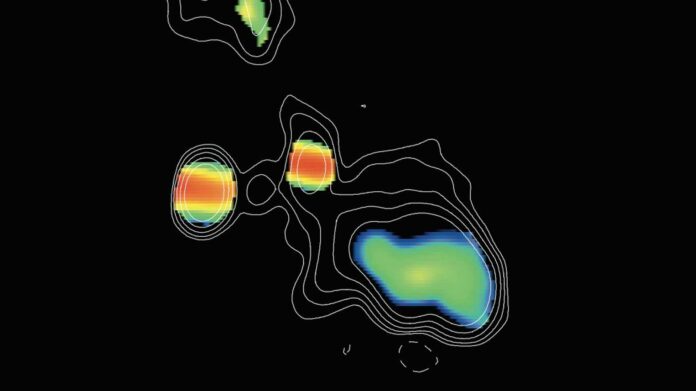One class of active galactic nuclei (AGN) with jets is called Compact Symmetric Objects (CSOs). They were classed to distinguish them from other compact AGNs with jets, in which relativistic factors cause the measured emission to be greatly amplified.
Researchers from Caltech recently conducted a study revealing that CSOs, previously believed to be young, have relatively limited lifespans. Previous theories regarding the makeup of CSOs are called into question by this new research.
Anthony (Tony) Readhead, the Robinson Professor of Astronomy, Emeritus, who led the investigation, said, “These CSOs are not young. You wouldn’t call a 12-year-old dog young even though it has lived a shorter life than an adult human. These objects are a distinct species that live and die out in thousands of years rather than the millions of years common in galaxies with bigger jets.”
In the latest research, the group examined previous observations and literature on over 3,000 CSO candidates, validating 64 of them as genuine and discovering fifteen more. The Very Long Baseline Array (VLBA) of the National Radio Astronomy Observatory (supported by the National Science Foundation, NSF) had previously observed all of these objects, and other high-resolution radio telescopes had also observed some of them.
Readhead says, “The VLBA observations are the most detailed in astronomy, providing images with details equivalent to measuring the width of a human hair at a distance of 100 miles.”
Vikram Ravi, assistant professor of astronomy at Caltech and a co-author of one of the studies, said, “Our analysis concludes that CSOs expel jets for 5,000 years or less and then die out. The CSO jets are very energetic, but they seem to shut off. The jets stop flowing from the source.”
Scientists surmise that tidal disruption events (TDEs) are the source of the short-lived jets in Compact Symmetric Objects (CSOs). This phenomenon occurs when an isolated star approaches a supermassive black hole too closely and engulfs it.

“We think that a single star gets ripped apart, and then all that energy is channeled into jets along the axis the black hole is spinning around,” Readhead says. “The giant black hole starts invisible to us, and then when it consumes a star, boom! The black hole has fuel, and we can see it.”
Readhead first suggested in the 1990s that tidal disruption events (TDEs) could be the energy source for Compact Symmetric Objects (CSOs). Only three CSOs had been found then, and there wasn’t enough observational evidence for TDEs, so the scientific community didn’t give this theory any thought.
Readhead opted to return to the research of CSOs in 2020, following a hiatus. He convened with colleagues via Zoom, and together, they combed through the literature to find CSOs that needed to be labeled correctly. They evaluated more than 3,000 potential CSOs over the following two years, and only a few met the requirements to be considered real CSOs.
Through their research, they discovered that, in contrast to more giant galaxies like Cygnus A, which have strong jets that can extend for hundreds of thousands of light-years and endure for tens of millions of years, CSOs are a distinct family of objects with jets that fade away considerably faster. CSO jets, on the other hand, are only visible for a maximum of 1,500 light-years and disappear after 5,000 years.
Astronomers suggest that the CSO jets likely form when a supermassive black hole snacks on not just any star but a substantial one.
Ravi says, “The TDEs we’ve previously seen only lasted for a few years. We think that the remarkable TDEs powering CSOs last far longer because the disrupted stars are very large, massive, or both.”
Researchers can follow the aging process of Compact Symmetric items (CSOs) over time by examining various radio images of these items; it’s like looking through a photo album of a CSO’s life to see how its jets have changed. Older CSOs have jets that extend farther from the black hole, while younger CSOs have shorter jets closer to their black holes.
While most CSO jets eventually disappear, astronomers predict that roughly one out of every 100 will develop into long-lived jets resembling those in galaxies like Cygnus A. In these exceptional instances, the galaxies are probably merging with other galaxies, which supply substantial fuel.
If the findings are confirmed with further observations, CSOs could offer a new avenue for studying how massive stars at the centers of galaxies interact with supermassive black holes.
“These objects are indeed a distinct population with their distinct origin, and it is up to us now to learn more about them and how they came to be,” Readhead says. “Being able to study these objects on timescales of years to decades rather than millions of years has opened the door to a whole new laboratory for studying supermassive black holes and the many unexpected and unpredictable surprises they hold.”
Journal Reference:
- Kiehlmann, S., M. L. Lister, A. C. S Readhead, I. Liodakis, Sandra O’Neill, T. J. Pearson, Evan Sheldahl, et al. 2024. “Compact Symmetric Objects. I. Toward a Comprehensive Bona Fide Catalog”. Astrophysical Journal 961 (2): 240. DOI: 10.3847/1538-4357/ad0c56.
